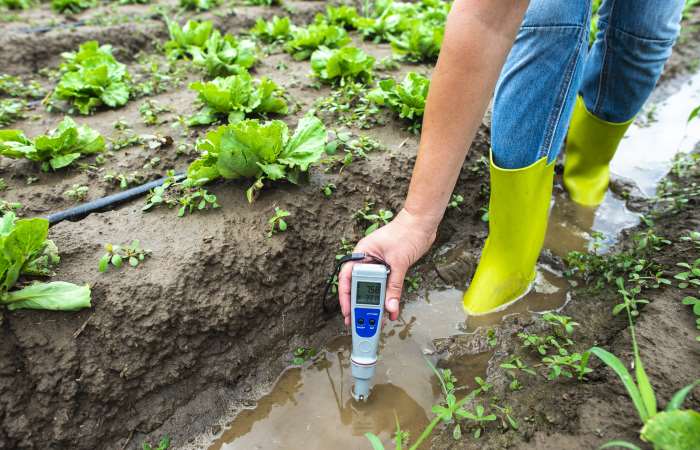Is the look and production of your garden pitiful?
Poor soil Ph can make or break your landscaping and garden plants, especially those that require a specific pH level to thrive, like azaleas or blueberries.

The quick solution is to use an at-home soil pH meter. Below, I explain the steps on how to use a pH meter and discuss the accuracy of electronic and strip test kits.
Once you know the soil pH you’re working with, you can easily adjust it to bring vitality back to your plants!
Best Way To Test pH In Soil
The best way on how to test soil pH is by using a pH meter.
These electronic devices are an affordable way to quickly spot-check soil samples across your property, so all your landscape and garden plants are growing in the best environment possible.
Many soil Ph testers are multi-function and include readings for moisture and light, which increases their value. Some specialty pH meters are made specifically to test in non-soil growing mediums or hydroponic gardens.
Related | Best Soil pH Meters
Follow these steps to test your soil:
- Dig a hole. Use a hoe or garden trowel to dig a hole four to six inches deep in the area you wish to test.
- Remove debris. If there are rocks, wood chips or sticks, leaves, or other chunky debris in the hole, you need to remove it. Use the end of your trowel to chop up and loosen the soil inside the hole.
- Add distilled water. The most accurate results come from using distilled water since tap water contains minerals that will alter the pH reading. Pour in a cup or so until the bottom of the hole is muddy.
- Insert your pH meter’s test probes into the muddy soil.
- Wait several minutes (per manufacturers’ directions), then check the readout to determine where your soil falls on the pH scale.
A reading lower than 7 indicates acidic soil, and above 7, the soil is alkaline.
If the number is exactly 7, your soil is neutral. Most plants grow perfectly fine in soil with a pH range between 6.5 and 7, but some plants need acidic soil while other plants and vegetables grow better in alkaline.
The best way to amend soil to become more alkaline is by adding lime. The best way to amend acidic soil is by adding sphagnum peat. Mix the amendment eight to 12 inches deep into the ground with a tiller or shovel.
How Accurate Are Soil pH Meters?
While the most accurate way to test soil pH is to send a sample off to your nearest agricultural extension office, waiting on results can take weeks.
When you want to plant your vegetable garden or get your flower beds ready, time is of the essence, so using an at-home meter is convenient.
An electronic pH meter can provide a reliably accurate result when put to use properly. For the average gardener, these meters are the fastest way to understand if your soil is too acidic or alkaline.
Look for a pH meter that offers a range between five and eight. Analog readouts may be harder to pinpoint nuances between numbers, where a digital readout is more concise.
Unless you are growing a very sensitive type of plant, any style of soil pH meter should deliver reliable accuracy for general growing needs.
Can You Use pH Strips To Test Soil?
A soil pH strip test can work to check levels, but they do entail different steps.
Another issue that occurs when using pH test strips is that it can be hard to differentiate between the colors on the chart and the color of your sample.
To use a test strip to check pH, you still need to dig out a soil sample from a hole four to six inches deep and place a few teaspoons in a clean glass bowl or jar.
Remove debris, and add in an equal part of distilled water as the soil in the container. Stir up the water and dirt well, then let the mixture sit for around half an hour.
Filter the sample through a coffee filter into another clean bowl, and then dip your testing strip entirely into the liquid. Give the test strip a couple of moments to develop and then compare the colors to the pH chart on the test kit packaging.
Soil pH test strips are very affordable, and if you don’t mind the extra time it takes to complete testing, they also provide accurate results.
In Summary
It’s easy to overlook soil pH when trying to figure out why your plants keep dying or continue to struggle.
Now you see that incorrect soil pH can be the culprit, and fixing it should be the first order of business. Knowing what pH level of garden soil you have is critical for success and can even be a way to alter the color of some flowers.
Expert gardeners know how to test soil ph with a ph meter and use it season after season to create stunning landscaping and abundant vegetable crops, and now you can too!











